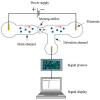Microfluidic and Nanofluidic Resistive Pulse Sensing: A Review
- PMID: 30400393
- PMCID: PMC6190343
- DOI: 10.3390/mi8070204
Microfluidic and Nanofluidic Resistive Pulse Sensing: A Review
Abstract
The resistive pulse sensing (RPS) method based on the Coulter principle is a powerful method for particle counting and sizing in electrolyte solutions. With the advancement of micro- and nano-fabrication technologies, microfluidic and nanofluidic resistive pulse sensing technologies and devices have been developed. Due to the unique advantages of microfluidics and nanofluidics, RPS sensors are enabled with more functions with greatly improved sensitivity and throughput and thus have wide applications in fields of biomedical research, clinical diagnosis, and so on. Firstly, this paper reviews some basic theories of particle sizing and counting. Emphasis is then given to the latest development of microfuidic and nanofluidic RPS technologies within the last 6 years, ranging from some new phenomena, methods of improving the sensitivity and throughput, and their applications, to some popular nanopore or nanochannel fabrication techniques. The future research directions and challenges on microfluidic and nanofluidic RPS are also outlined.
Keywords: microfluidics and nanofluidics; particle sizing and counting; resistive pulse sensing; review.
Conflict of interest statement
The authors declare no conflict of interest.
Figures







References
-
- Wang Z., Wang X., Liu S., Yin J., Wang H. Fluorescently imaged particle counting immunoassay for sensitive detection of DNA modifications. Anal. Chem. 2010;82:9901–9908. - PubMed
-
- Barnard J.G., Singh S., Randolph T.W., Carpenter J.F. Subvisible particle counting provides a sensitive method of detecting and quantifying aggregation of monoclonal antibody caused by freeze-thawing: Insights into the roles of particles in the protein aggregation pathway. J. Pharm. Sci. 2011;100:492–503. - PubMed
-
- Benech H., Théodoro F., Herbet A., Page N., Schlemmer D., Pruvost A. Peripheral blood mononuclear cell counting using a DNA-detection-based method. Anal. Chem. 2004;330:172–174. - PubMed
-
- Huang B., Wu H.K., Bhaya D., Grossman A., Granier S., Kobilka B.K., Zare R.N. Counting low-copy number proteins in a single cell. Science. 2007;315:81–84. - PubMed
Publication types
LinkOut - more resources
Full Text Sources
Other Literature Sources

